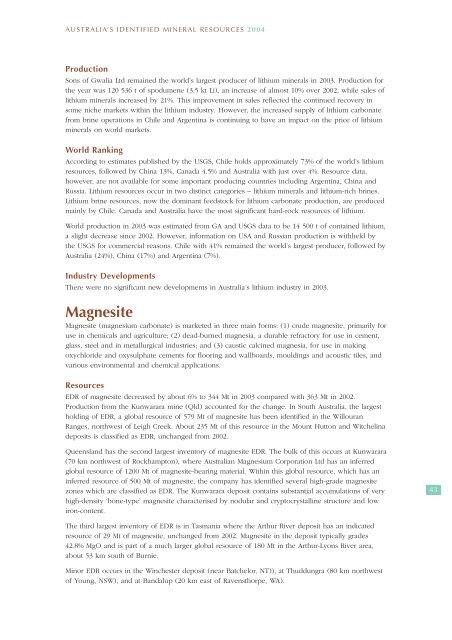australia's identified mineral resources 2004 - Geoscience Australia
australia's identified mineral resources 2004 - Geoscience Australia
australia's identified mineral resources 2004 - Geoscience Australia
Create successful ePaper yourself
Turn your PDF publications into a flip-book with our unique Google optimized e-Paper software.
AUSTRALIA’S IDENTIFIED MINERAL RESOURCES <strong>2004</strong><br />
Production<br />
Sons of Gwalia Ltd remained the world’s largest producer of lithium <strong>mineral</strong>s in 2003. Production for<br />
the year was 120 536 t of spodumene (3.5 kt Li), an increase of almost 10% over 2002, while sales of<br />
lithium <strong>mineral</strong>s increased by 21%. This improvement in sales reflected the continued recovery in<br />
some niche markets within the lithium industry. However, the increased supply of lithium carbonate<br />
from brine operations in Chile and Argentina is continuing to have an impact on the price of lithium<br />
<strong>mineral</strong>s on world markets.<br />
World Ranking<br />
According to estimates published by the USGS, Chile holds approximately 73% of the world’s lithium<br />
<strong>resources</strong>, followed by China 13%, Canada 4.5% and <strong>Australia</strong> with just over 4%. Resource data,<br />
however, are not available for some important producing countries including Argentina, China and<br />
Russia. Lithium <strong>resources</strong> occur in two distinct categories – lithium <strong>mineral</strong>s and lithium-rich brines.<br />
Lithium brine <strong>resources</strong>, now the dominant feedstock for lithium carbonate production, are produced<br />
mainly by Chile. Canada and <strong>Australia</strong> have the most significant hard-rock <strong>resources</strong> of lithium.<br />
World production in 2003 was estimated from GA and USGS data to be 14 500 t of contained lithium,<br />
a slight decrease since 2002. However, information on USA and Russian production is withheld by<br />
the USGS for commercial reasons. Chile with 41% remained the world’s largest producer, followed by<br />
<strong>Australia</strong> (24%), China (17%) and Argentina (7%).<br />
Industry Developments<br />
There were no significant new developments in <strong>Australia</strong>’s lithium industry in 2003.<br />
Magnesite<br />
Magnesite (magnesium carbonate) is marketed in three main forms: (1) crude magnesite, primarily for<br />
use in chemicals and agriculture; (2) dead-burned magnesia, a durable refractory for use in cement,<br />
glass, steel and in metallurgical industries; and (3) caustic calcined magnesia, for use in making<br />
oxychloride and oxysulphate cements for flooring and wallboards, mouldings and acoustic tiles, and<br />
various environmental and chemical applications.<br />
Resources<br />
EDR of magnesite decreased by about 6% to 344 Mt in 2003 compared with 363 Mt in 2002.<br />
Production from the Kunwarara mine (Qld) accounted for the change. In South <strong>Australia</strong>, the largest<br />
holding of EDR, a global resource of 579 Mt of magnesite has been <strong>identified</strong> in the Willouran<br />
Ranges, northwest of Leigh Creek. About 235 Mt of this resource in the Mount Hutton and Witchelina<br />
deposits is classified as EDR, unchanged from 2002.<br />
Queensland has the second largest inventory of magnesite EDR. The bulk of this occurs at Kunwarara<br />
(70 km northwest of Rockhampton), where <strong>Australia</strong>n Magnesium Corporation Ltd has an inferred<br />
global resource of 1200 Mt of magnesite-bearing material. Within this global resource, which has an<br />
inferred resource of 500 Mt of magnesite, the company has <strong>identified</strong> several high-grade magnesite<br />
zones which are classified as EDR. The Kunwarara deposit contains substantial accumulations of very<br />
high-density ‘bone-type’ magnesite characterised by nodular and cryptocrystalline structure and low<br />
iron-content.<br />
43<br />
The third largest inventory of EDR is in Tasmania where the Arthur River deposit has an indicated<br />
resource of 29 Mt of magnesite, unchanged from 2002. Magnesite in the deposit typically grades<br />
42.8% MgO and is part of a much larger global resource of 180 Mt in the Arthur-Lyons River area,<br />
about 53 km south of Burnie.<br />
Minor EDR occurs in the Winchester deposit (near Batchelor, NT)), at Thuddungra (80 km northwest<br />
of Young, NSW), and at Bandalup (20 km east of Ravensthorpe, WA).

















